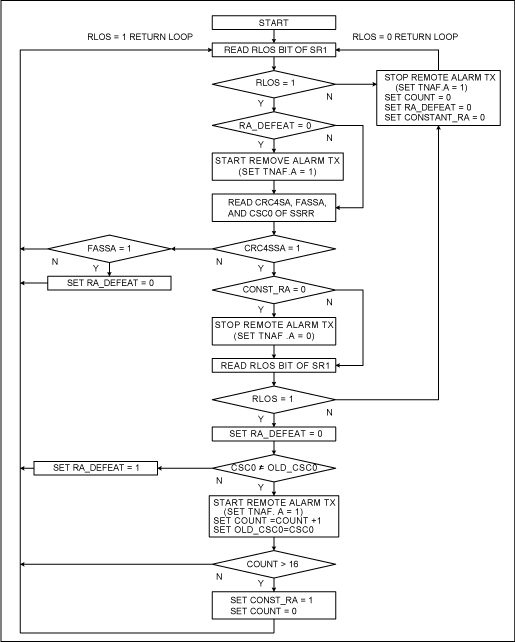
Introduction to ETS 300-011The European Telecommunications Standards Institute, better known as ETSI, is a standards body that operates throughout the European Union. Their goal is to produce the telecommunications standards that will be used for decades to come throughout Europe and beyond. Further information on the ETSI organization can be found on their website at www.etsi.org.
The ETS 300-011 specification is intended for designs with an Integrated Services Digital Network (ISDN), Primary rate user-network interface. ETS 300-011 describes the Layer 1 specification and test principles for the ISDN interface. One aspect of the ISDN interface is the use of the Remote Alarm for notification of a line fault. This application note focuses on the use of the Remote Alarm and how to implement it in software.
ETS 300-011 Software Loop DescriptionThe flowchart in Figure 1 can be used to implement the Remote Alarm functions in Dallas Semiconductor's singlechip transceivers or framers. It is based on the ETS 300-011 specification and designed to guide the software development.
Software Initialization SequenceThe following seven initialization tasks need to be performed prior to the flow chart sequence.
- Power Up All Necessary Hardware.
- Reset All SCT or Framer Registers to 0x00.
- Initialize All SCT or Framer Registers to Proper Values.
- Set Variable COUNT = 0.
- Set Variable OLD_CSC0 = 0.
- Set Variable RA_DEFEAT = 0.
- Set Variable CONST_RA = 0.

Figure 1. Software flowchart.
Notes:
- The Remote Alarm is transmitted using the TNAF Register. When the A bit of the TNAF Register is set to 1, the Remote Alarm is being transmitted.
- The RLOS bit in the SR1 Registers is a latched status bit. To properly read the current status of the RLOS bit, the software should use a Write-Read-Write-Read sequence. The second Read will ensure the software obtains the current status of the RLOS bit.
欢迎分享,转载请注明来源:内存溢出

 微信扫一扫
微信扫一扫
 支付宝扫一扫
支付宝扫一扫
评论列表(0条)